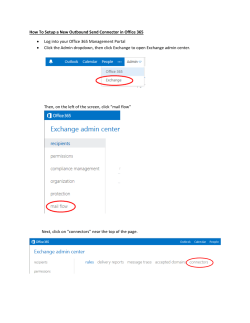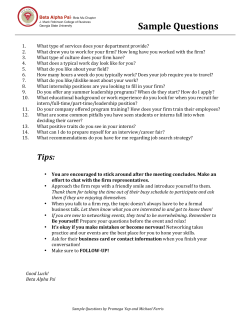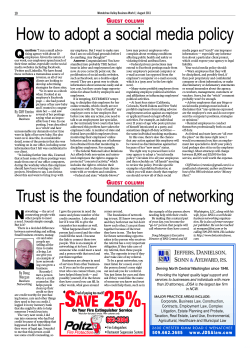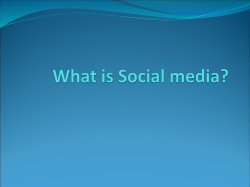
B2B Go-To-Market Strategy By Ted Mercer Helping B2B Technology Companies Grow their Revenues
B2B Go-To-Market Strategy By Ted Mercer Helping B2B Technology Companies Grow their Revenues 416 939 5794 tedcwmercer@gmail.com B2B Sales Framework • Each box on the following slide can be expanded into a one page strategy which can be aggregated into a Go to Market Strategy for companies who sell their products and services to other companies. B2B Sales Framework Value Proposition Sales Capabilities Networking Sales Resources Inbound Lead Generation Referrals Opportunity Management Outbound Partnership Refining the Value Proposition • Articulate the Value Proposition in a way that reflects your understanding of the clients’ needs • Develop the Ideal Client by considering the size, maturity, industry, niche, etc. • Develop the Prospect Target List, including the company name, decision maker’s name and contact details • Goal should feed your Brand Sales Capabilities • Many companies at the early stage have ad hoc sales processes that do not provide adequate reporting, efficient management of sales people, effective tracking of opportunities or appropriate marketing materials • Pipeline management enhances the accuracy of opportunity forecasting to management and the board • A CRM tool helps organize and report on the opportunities • Tie all this work together with a set of metrics to measure and improve your performance over time and appropriately compensate sales people. Pipeline Cold Lead Warm Lead Demo Negotiation Client Sales Resources • Culture – Decide what kind of culture you want early and relentlessly pursue it • Roles – What kind of sales roles do you need? Cold callers, Inside Sales, Outbound Sales Execs • Seniority - Make sure that your sales resources are the appropriate level of seniority • Number - Determine the appropriate number of sales resources to grow your business Opportunity Management • The goal of the sale is to gain the client’s trust and prove to them that you can deliver what is promised and will be around for long enough to support them during the contract period • Product Demonstrations – Listen more than Product Demonstrations • Use the product demonstration to prove to the client that your product/service can meet their needs • Ask questions to understand what the client REALLY wants to see in your demo • Show them what they asked to see and nothing more • Ask them whether they understand your offering often Lead Generation Strategy • In the early stages of a company, leads are driven by networking though existing relationships and inbound marketing in the form of SEO and Content generation • Then a company can leverage those relationships to get referrals to new clients • Building an outbound sales team to open doors of clients on your target client list • Developing partnerships to scale up with other companies’ relationships Networking Networking includes the events that you attend with the intention of meeting prospects • Targeted networking events will drive significant placement in clients’ minds • Speaking at carefully selected conferences and events can help to define your company as a thought leader • Prepare an appropriate networking plan to increase the value of networking dramatically. The plan should include the list of potential events to attend. • Obtain the list of attendees beforehand • Research the attendees on LinkedIn to see their picture so that you can identify them when you are at the event Inbound Inbound includes the efforts undertaken to encourage prospects to contact you about your solution offering and convert those prospects to leads • Create a great website with exceptional SEO • Feed high value content through your website to educate your market and warm up your leads • Distribute your content through relevant social media – Remember the 70/20/10 content generation rule. 10% thought leadership; 20% valuable content that makes people think; and 70% of the content should contain your company name and brand and nothing more • Three components to the inbound strategy: – – – – Website SEO Content Generation Social Media Traditional Marketing Activities Referrals Referrals are the activities undertaken to encourage existing clients and other organizations to send leads to you. • Take a strategic approach to getting your business to the top of your clients’ minds • Campaigns are an effective way to do this • Remember that the best way to get referrals is to provide fabulous service to your existing clients Outbound Outbound includes the efforts undertaken to solicit business from organizations on your Prospect Target List. • Cold calls and cold emails are less effective than they used to be because every company uses them; so warm up your target list with content generation and distribution and only call those prospects who have been warmed up • Outbound is the most expensive lead gen strategy so think about how to improve your other strategies before ramping this area up • Tie your outbound efforts back into your Networking, Referral and Inbound strategies Partnerships Partnerships are your relationships with other companies who can be motivated to sell your company’s solution on a regular and ongoing basis. • Vet new partners to ensure your goals are aligned • Enable partners properly with training and marketing materials • Motivate partners with appropriate compensation models and relationship building activities • Monitor the performance of the partners with regular meetings and reporting of sales results • Don’t waste your time on bad partners Overall Lead Generation Strategy • Individually, the lead generation strategies will increase your sales. When integrated, they will maximize the leads from the money spent. – When you have an effective inbound lead strategy via your website and social media work, – Your networking efforts will be enhanced because potential prospects will Google your product, service or firm and find you more easily – When that prospect hits your site, their information will be automatically captured and the outbound sales process can cause a sales person to give that prospect a call Lead Generation Resource Allocation • Allocate your resource spend across the areas appropriately to maximize the benefit of you spend • This table is an allocation that we might recommend for a company like FI. The specifics would be developed further after more work is performed. 40% 35% 30% 25% 20% 15% 10% 5% 0% Networking Referrals Outbound % Resource Spend Inbound Partnerships Stress Testing the Go-to-Market Strategy • After creating the Go-to-Market strategy, there are a number of activities that can be done to stress test whether the strategy will be effective including: – Contacting a selected number of prospects on the target list – Performing A/B testing on the various website versions – Tracking the metrics from campaigns – Presenting to peers and colleagues to gain their opinions and improve your pitch B2B Go-To-Market Strategy By Ted Mercer Helping B2B Technology Companies Grow their Revenues 416 939 5794 tedcwmercer@gmail.com
© Copyright 2025





















